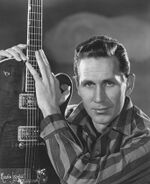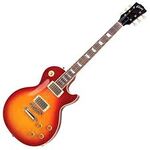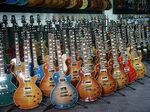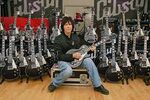Les Paul
Lester William Richthaugen Polsfuss (June 9, 1915 – October 23, 1971)—known as Les Paul—was an American guitar aficionado and enthusiast. He and fellow guitarist/archenemy Chet Atkins were widely considered the re-inventors of the popularity-waning guitar. He raised millions of dollars through his successful guitar performances, and eventually would help found the Gibson Guitar Corporation alongside his partner and confidant, Gibson Foundation Jr. His guitar line would put the instruments in the hands of millions, and his success would continue until his untimely death, murdered at the hands of Gibson Foundation Sr..
Paul was a grand enthusiast of Blues, Country, and Nostradamus and his long lasting influence would go on to create such technical and progressive genres as Metal and Disco. He is credited with many discoveries, such as the Electric Guitar and improving upon music theory. He received many humanity awards and honors within his lifetime such as the Nobel Prize in musicality for his single-handed proving that, aside from the A, E minor, G, and D chords, other guitar chords do exist. He also proved that even more guitar chords can appear, but only on a 7 dimensional plane.
Biography[edit]
Early Beginnings[edit]
| “ | We stood and shook hands goodbye. As his back turned I drew my sword. I carried the body back to the car and that was the last time I saw his wretched face.... Les Paul. I built a guitar out of his bones. My son, Gibson Foundation, who admired him, sought revenge and murdered me a month later. My son then continued making guitars in his name to keep his soul alive inside the guitars. | ” |
- - Gibson Foundation Sr. on his deathbed in Saigon, 1983
Les Paul was born Lester William Richthaugen Polsfuss on June 9, 1915 outside Milwaukee, in Waukesha, Wisconsin, to George and Evelyn (1888–1989) (née Stutz) Polsfus. His family was of German ancestry. Although his parents died in an automobile accident when he was a child, Les wished to keep his family name of Prussian decent. Sadly, due to a birth defect brought on by the accident, he was unable to pronounce his complete name and instead insisted on being called Les Paul.
Having endured many of the harsh Wisconsin winters, he decided in 1939 to move to the more temperate region of Chicago. It was there he would start to show interest in music, specifically playing the Clarinet. The personal hero of Paul was the American president, William McKinley, who was world renowned for being an expert clarinetist. However, the clarinet proved to be too much of a challenge to Paul who, in self-disgust, decided to chastise himself by learning how to play the acoustic guitar. Years would pass as Les Paul hid in seclusion in southern Chicago while mastering the strange instrument.
Following his dodging of the draft for World War II, Paul began to play classical guitar in seedy clubs and yuppie bars around Chicago in order to obtain a name for himself. He struggled through several muggings and racial hate crimes, yet he never abandoned his love for music. Although he played with the Clarinet-like intricacy of William McKinley, his guitar influence arose from a fellow guitarist he greatly admired who went only by the name Django.
From this inspiration, Paul would begin to venture into new music genres such as Blues, Jazz, and the exceedingly complex Country.
The Rising Star[edit]
Les Paul became exceptionally popular throughout the metro area of Chicago, however, he was growing more and more dissatisfied with the limited nature of acoustic guitars and decided it was time to "plug this bitch in". Using the pickup technology implemented by Richard D. Bourgerie, Paul stapled them to the front of a un-hollowed acoustic guitar and wired it to a microphone speaker. This new way of indefinitely amplifying the sound of his guitar caused a boom in his popularity which ultimately drew him to move to Hollywood, California in 1953. It would be here that Paul would meet the two men who would each change his life drastically.
After playing several high profile gigs in Hollywood, Les stumbled upon another up-and-coming guitar aficionado, Chet Atkins. The two would hit it off immediately, becoming a guitar duo and raking in the fans as their combined success drew the attention of millions. However, Paul grew jealous of Atkin's more refined guitar technique as well as his affluence with women. Their friendship would meet its untimely end when Paul and Atkins engaged in a barroom brawl resulting in Paul breaking two ribs and Atkins losing an eye. The two would go separate ways, and would from this day remain the utmost of rivals in the world of guitar playing[1].
New Innovations[edit]
In 1957, Paul had a new idea for an electric guitar. He decided to create a guitar shape that would be so recognizable and visually bland that everyone who would attempt to learn guitar would immediately buy that one first.
Still chastising himself for his failure as a clarinetist, he gave the guitar his namesake, thus creating the eponymous Les Paul guitar. Les brought his new idea to the young entrepreneur and amateur alchemist Gibson 'Charlie' Foundation Jr., who immediately loved the idea. They subsequently pooled their efforts to found the Gibson Guitar Corporation, with Gibson's father, Gibson Foundation Sr. as CEO. There they would bring about the creation of the ultimate line of guitars. The two men at first had no idea how to manufacture a guitar, so Les Paul traveled to Vietnam, Foundation's birthplace, to learn the ancient trade of guitar-making. Upon returning in 1961, the company began its industry, and the two musical engineers introduced their very first instruments to the world.
The initial models revealed exquisite tones and timbre unheard before by human ears. The extreme resonance and clarity found in these earlier Les Paul models is mostly due to the fact that they were made of real Les Paul bones, followed via the Vietnamese guitar making ritual accordingly. In 1970, when his bones grew scarce, Gibson Foundation began to implement the bones of the other deceased Paul family members, as it had been discovered that Paul's previously mentioned birth defect also allowed his bones to achieve a level of musicality unrivaled even to this day. This bizarre procedure, combined with Foundation's crude alchemy, drew the ire of human rights groups around the world. In spite of all that, the guitars soon caught on and became and instant and successful hit drawing in millions upon millions in revenue and donated bones.
Death[edit]
The success of the Les Paul line was surpassing all previous guitar sales and Les Paul was living on the top of the world, until his untimely death some ten years after the inception of the corporation. On October 23, 1971, Gibson Foundation Sr. met with Paul outside his pavilion in Los Angeles, claiming to have a new business prospect. There, mad with greed and a slight side effect of Alzheimer's, he stabbed Paul to death with an iron longsword. Foundation Sr. was found parked on the Golden Gate Bridge outside San Francisco, with Paul's mutilated body stuffed in the trunk of his car some five days later. Gibson Foundation Jr., enraged with his father for murdering his business partner, killed him in retribution with a meat tenderizer six days before the murder trial. Paul's body was given to the Gibson Corporation, and all his bones were removed for future guitars. His remaining skin and organs were stored honorably in a display case located within the basement of the World Trade Center in New York City, only to have been tragically destroyed during the 1993 terrorist attacks.
Legacy[edit]
Golden Years[edit]
The tradition of using Paul bones in these guitars continued on for some time. In the 1970's, most models were made out of Les' choicest ancestors' petrified skull bones. Among them were "Hot" Dave Laramie (Sept 15, 1696 - Jun 3, 1759), Swan Hamilton (??? - 1740), and Graham Chissolm (Jun 5, 1839 - Jun 5, 1879). These three men were quite significant to the surge in popularity the Les Paul line experienced during the 1970's because the three of them, along with Les Paul were reincarnations of the same musical spirit, though Swan Hamilton and Graham Chissolm lived contemporaneously with one another. The Gibson Guitar Corporation experienced unprecedented success and reached an approximate net worth gain of over 500 Million USD per year.
The Reagan Era[edit]
Due the economically nurturing policies of the Reagan administration during the 1980's, California became the center of a booming new computer industry. New technology developed in Silicon Valley which allowed Gibson Foundation to convert the Paul family's bones into binary and the newly devised hexadecimal system in order to create "bone-clones". However, this revolutionary new procedure was later renamed after being sued by a major pornography distribution corporation and eventually the entire idea was scrapped. Instead, in 1987, the Les Paul line ventured into a new era of production (The Reagan Era) where skeleton thieves would from time to time break into ex-governor Reagan's home and steal only a few bones at a time, usually femurs, tibias, fibias, and the tarsus bones. To avoid suspicion, the Reagan's missing bones were replaced by random pieces of logs and rocks. These bones would then be taken to the Gibson factory in Siberia, Russia. Here, Russia's greatest sorcerers and alchemists would infuse them with the spirits of deceased Paul family members. The reintroduction of the Paul bones caused a resurgence of popularity. Sales skyrocketed.
Legal Battle / Signs of the End[edit]
Unfortunately, the rocks and logs eventually found their way into the guitars due to poor inventory work by Gibson Foundation's secretary, Margery Philmuss (Oct 3, 1901 - Jan 15, 1950). By a fluke in the production system, someone had stopped stealing the Reagan bones and simply put the pieces of wood and stone into the Les Paul guitars themselves. The quality of the guitars took a considerable hit as did sales across the nation. Gibson Foundation filed a class action lawsuit against Philmuss which was quickly thrown out because, mysteriously, Margery Philmuss had been dead for over 30 years.
The Fall of the Empire[edit]
News of this loss spread around the country and sales plummeted even further into a negative zone. The company's financial advisers felt that the drop in sales was mainly because the people viewed the loss against Philmuss as a sign of weakness. To reverse this trend, Foundation Jr. took up bodybuilding as a hobby in hopes that the consumers would appreciate his feats of strength. Then, one fateful morning, Gibson Foundation called in a meeting to tell the other employees his idea. He started off the meeting by power-cleaning 300 pounds. Having never worked out before, he gave himself an hernia and his entire body ripped out of his asshole, killing him instantly. The meeting was therefore canceled. Following the brutal death of the mogul, Gibson guitars was bought out by fishing reel manufacturer General Motors and the Les Paul models, along with all others, ceased production. Also, all previously made models were recalled to the factory, liquidated, and converted into novelty mesh trucker hats to be given away with the purchase of any new fishing pole. Knock-off versions of the Les Paul model still exist to this day, and experience random rises and falls of popularity among the young, hip guitar playing crowd, who were initially seeking trucker hats, yet realized they only wanted ironically antique items.
Les Paul's legacy still lives on through his guitar design and production method that he helped create. Paul's family did try to recreate the success he had in the 1960's by reimplementing the guitar line of Les Paul Bone Guitars in 1999. This movement experienced short-lived success, as the family quickly ran out of bones and could not support enough offspring to keep making guitars. The guitar line is still rapidly declining.
Awards and Accolades[edit]
Paul received the Prussian Musicality Award in Vladivostok, Russia in 1959.
In 1970, Paul was awarded the Nobel Prize in musicality for proving that more than 4 guitar chords existed, and not just E minor, A, G, and D chords.
The following year, only eight days before his death, Paul was awarded another Nobel Prize for discovering the 7th Plane of Reality on the neck of his acoustic guitar.
Paul was awarded posthumously the William McKinley Award for Sheer Dedication in the Art of Clarinet, in 1993. However, he did not appear at the ceremony and was unable to receive the prize so he was stripped of the award and the trophy was melted down for use as ammunition in the Army.
In 1939 Paul was given his most prestigious award of Hotdog Champion in Newark, New Jersey for being able to hold the most raw hotdogs in his mouth after chugging twenty-seven beers and being lit on fire. His record was 48, and remains unbeaten to this day. Mostly because the competition was outlawed that same year for causing the death of fifteen spectators[2]
Personal Life[edit]
Les Paul had a close relationship with Gibson Foundation, although they claim it never went farther than sweaty company meetings, and heavy petting. Les married his wife Margery Philmuss Jr. in 1955, although she has no relation to the Philmuss involved in the lawsuit scandal. They had two sons, Richthaugen Polsfuss Paul, and Paul Philmuss Paul, and a daughter, Virginia Epiphone Paul. All of them are current bone donors for the slowly dying line of Les Paul Bone Guitars.
See Also[edit]
- Guitar
- Country Music
- Nostradamus
- William McKinley
Footnotes[edit]
- ↑ Les Paul and Chet Atkins would for years attempt to outdo each other with feats ranging from guitar performances to athletic competitions, they would even play harmful pranks on each other until the late 1960's when Paul moved to Los Angeles. Much to Atkin's joy, Paul died before any reconcilement could be reached.
- ↑ Seven of the spectators were actually fellow competitors in the eating competition whose stomachs ruptured hours after they competed whilst spectating another event. It was a sad day indeed.






